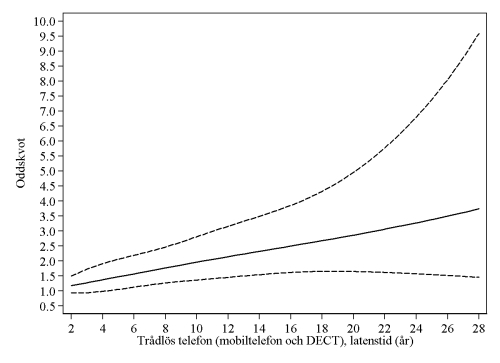Sir Austin Bradford Hill gav i ett berömt tal år 1965 synpunkter på sambandet mellan tobaksrökning och lungcancer. Epidemiologiska studier kan visa en ökad risk på en association men inte att exponeringen i fråga orsakar den åkomma som undersöks, t.ex. cancer.
Bradford Hill presenterade 9 synpunkter, ofta kallade för kriterier, för ett orsakssamband. Han påpekade dock att inte alla villkor behöver vara uppfyllda för att en exponering skall anses orsaka en sjukdom.
Vi har använt oss av dessa villkor för att bedöma om exponering för radiofrekventa fält (mikrovågor) från mobiltelefoner och trådlösa bordstelefoner (DECT) kan orsaka hjärntumörer. Vi finner därvid att de flesta kriterier är uppfyllda och att radiofrekventa fält skall anses orsaka vissa former av hjärntumörer (elakartade och acusticusneurinom). Detta motsvarar Grupp 1 enligt IARC vid WHO ”Sufficient evidence in humans”.
Vår artikel har publicerats efter sedvanlig granskning i den vetenskapliga tidningen Reviews on Environmental Health (DOI 10.1515/reveh-2013-0006). Nedan ges en engelsk sammanfattning av artikeln.
Lennart Hardell and Michael Carlberg
Using the Hill viewpoints from 1965 for evaluating
strengths of evidence of the risk for brain tumors
associated with use of mobile and cordless
phones
Abstract
Background: Wireless phones, i.e., mobile phones and
cordless phones, emit radiofrequency electromagnetic
fields (RF-EMF) when used. An increased risk of brain
tumors is a major concern. The International Agency for
Research on Cancer (IARC) at the World Health Organization
(WHO) evaluated the carcinogenic effect to humans
from RF-EMF in May 2011. It was concluded that RF-EMF
is a group 2B, i.e., a “possible”, human carcinogen. Bradford
Hill gave a presidential address at the British Royal
Society of Medicine in 1965 on the association or causation
that provides a helpful framework for evaluation of
the brain tumor risk from RF-EMF.
Methods: All nine issues on causation according to Hill
were evaluated. Regarding wireless phones, only studies
with long-term use were included. In addition, laboratory
studies and data on the incidence of brain tumors were
considered.
Results: The criteria on strength, consistency, specificity,
temporality, and biologic gradient for evidence of
increased risk for glioma and acoustic neuroma were
fulfilled. Additional evidence came from plausibility and
analogy based on laboratory studies. Regarding coherence,
several studies show increasing incidence of brain
tumors, especially in the most exposed area. Support for
the experiment came from antioxidants that can alleviate
the generation of reactive oxygen species involved in
biologic effects, although a direct mechanism for brain
tumor carcinogenesis has not been shown. In addition,
the finding of no increased risk for brain tumors in subjects
using the mobile phone only in a car with an external
antenna is supportive evidence. Hill did not consider all
the needed nine viewpoints to be essential requirements.
Conclusion: Based on the Hill criteria, glioma and acoustic
neuroma should be considered to be caused by RF-EMF
emissions from wireless phones and regarded as carcinogenic
to humans, classifying it as group 1 according to the
IARC classification. Current guidelines for exposure need
to be urgently revised.


